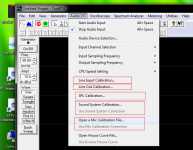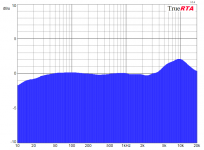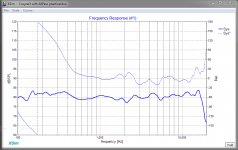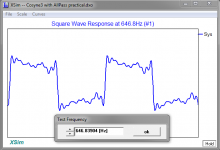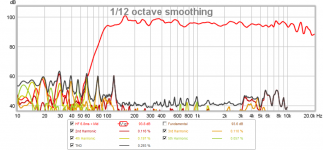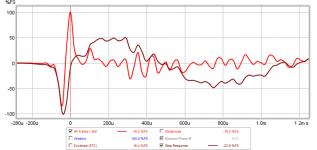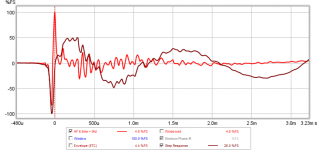I'm using two Bill Fitzmaurice T18 subs, that are corner-loaded to get the extra low-end extension Bill recommends (about an octave). Aside from the DSP in my receiver, yes, I have a computer-based option I can use.
I'll try to get the extra panels for the woofers roughed out today, and maybe put the top on the tractrix horn so we can see what it sounds like with the 3fe25
I'll try to get the extra panels for the woofers roughed out today, and maybe put the top on the tractrix horn so we can see what it sounds like with the 3fe25
After completing this, write down that delay as you will use it over and over whenever reconfiguring the Trynergy setups in DSP. The initial guess was close but the small adjustments made a huge difference.
Hi X, one has to time align the mids/tweeters again if one changes their xo'ing slopes, same value cannot be used with different setups. This is because different slopes add different amount of group delay higher order slopes add more group delay and phase shift. Also eq'ing the xo area affects the group delay naturally.
Did you look at the step response of your newest setup?
Legis,
Yes, I mentioned the XO slopes affecting the delay in post 195. I haven't had a chance to pull the step response from REW yet. Looking at it I think it looks like a triangular response followed by large slow (long) timescale fluctuations. I need to figure out what type of response in frequency range makes an ideal step response. I have steep XO slopes and don't know if that is affecting it adversely.
Yes, I mentioned the XO slopes affecting the delay in post 195. I haven't had a chance to pull the step response from REW yet. Looking at it I think it looks like a triangular response followed by large slow (long) timescale fluctuations. I need to figure out what type of response in frequency range makes an ideal step response. I have steep XO slopes and don't know if that is affecting it adversely.
Legis,
Yes, I mentioned the XO slopes affecting the delay in post 195. I haven't had a chance to pull the step response from REW yet. Looking at it I think it looks like a triangular response followed by large slow (long) timescale fluctuations. I need to figure out what type of response in frequency range makes an ideal step response. I have steep XO slopes and don't know if that is affecting it adversely.
Oh sry, did not notice that
If you have access to an oscilloscope (or audio software that does the same thing) and microphone, you can download this wav file (~50MB) of a repeated square wave sweep. Set the scope triggering around 0, and play the sweep through the speaker.
http://libinst.com/SynergyCalc/squarewave%20sweep.wav
Or you can instead download this mono version (~3MB) containing only ~30seconds of the sweep:
http://libinst.com/SynergyCalc/squarewave%20sweep%20mono%2030sec.wav
http://libinst.com/SynergyCalc/squarewave%20sweep.wav
Or you can instead download this mono version (~3MB) containing only ~30seconds of the sweep:
http://libinst.com/SynergyCalc/squarewave%20sweep%20mono%2030sec.wav
Bwaslo,
Thanks for the waveforms. I have the option to use REW to generate square waves. I wonder if recording the sound as a wav file with Audacity is good enough to capture if the speaker output is truly a square wave. I guess the amp also has to be up to the task as well.
Thanks for the waveforms. I have the option to use REW to generate square waves. I wonder if recording the sound as a wav file with Audacity is good enough to capture if the speaker output is truly a square wave. I guess the amp also has to be up to the task as well.
If you have access to an oscilloscope (or audio software that does the same thing) and microphone, you can download this wav file (~50MB) of a repeated square wave sweep. Set the scope triggering around 0, and play the sweep through the speaker.
http://libinst.com/SynergyCalc/squarewave%20sweep.wav
Or you can instead download this mono version (~3MB) containing only ~30seconds of the sweep:
http://libinst.com/SynergyCalc/squarewave sweep mono 30sec.wav
Bwaslo, how did you generate those files? Could you by generate a new square wave sweep, one that sweeps between 50Hz and 500Hz and the speed of the sweep is little slower, 50Hz-500Hz in a ~40sec for example?
edit. never mind, I found the way to do it in Audacity.
Last edited:
I did try tractrix xcel sheet but do not work, it is damaged after download and want repair it did now work, looks lik thing get damaged when I download it, I have removed avira because these program slowdown the pc very badly.
sheet did work past week I do not understand.
now it is fast again.
Can it be that I need excel 2010 or so, I have 2007.
thanks,
sheet did work past week I do not understand.
now it is fast again.
Can it be that I need excel 2010 or so, I have 2007.
thanks,
Bwaslo, how did you generate those files? Could you by generate a new square wave sweep, one that sweeps between 50Hz and 500Hz and the speed of the sweep is little slower, 50Hz-500Hz in a ~40sec for example?
edit. never mind, I found the way to do it in Audacity.
Legis,
How do you record the square wave sound produced by your horns? Do you play the wav file and use Audacity as a wav recorder, then look at sound wav file by zooming in until you see the individual waves? I don't have an oscope anymore. Wish I kept that thing around.
Legis,
How do you record the square wave sound produced by your horns? Do you play the wav file and use Audacity as a wav recorder, then look at sound wav file by zooming in until you see the individual waves? I don't have an oscope anymore. Wish I kept that thing around.
Hi X, there are many ways, but this is propably the most "reveraling" way is to video it (like bwaslo has also done). See if you can make some measurements like this, you only need the basic measurement tools: http://www.diyaudio.com/forums/subwoofers/258706-study-dipole-cardioid-bass-horn-37.html#post4058732
Square waves with the 3FE22 Trynergy
I used the O-scope program that Legis suggested and the built in sound generator in REW to make the square waves. (I compared them against square waves in Audacity and got the same result).
I did it at several frequencies and found some that made more "square" than others and in general they look more like spikey triangle waves. The square wave test is indeed difficult for a speaker to replicate. I am not sure how much of this is the amp or the speaker. Maybe a good test would be a bare driver in an OB at low amplitude to see if it can make a square wave to start with.
90 Hz
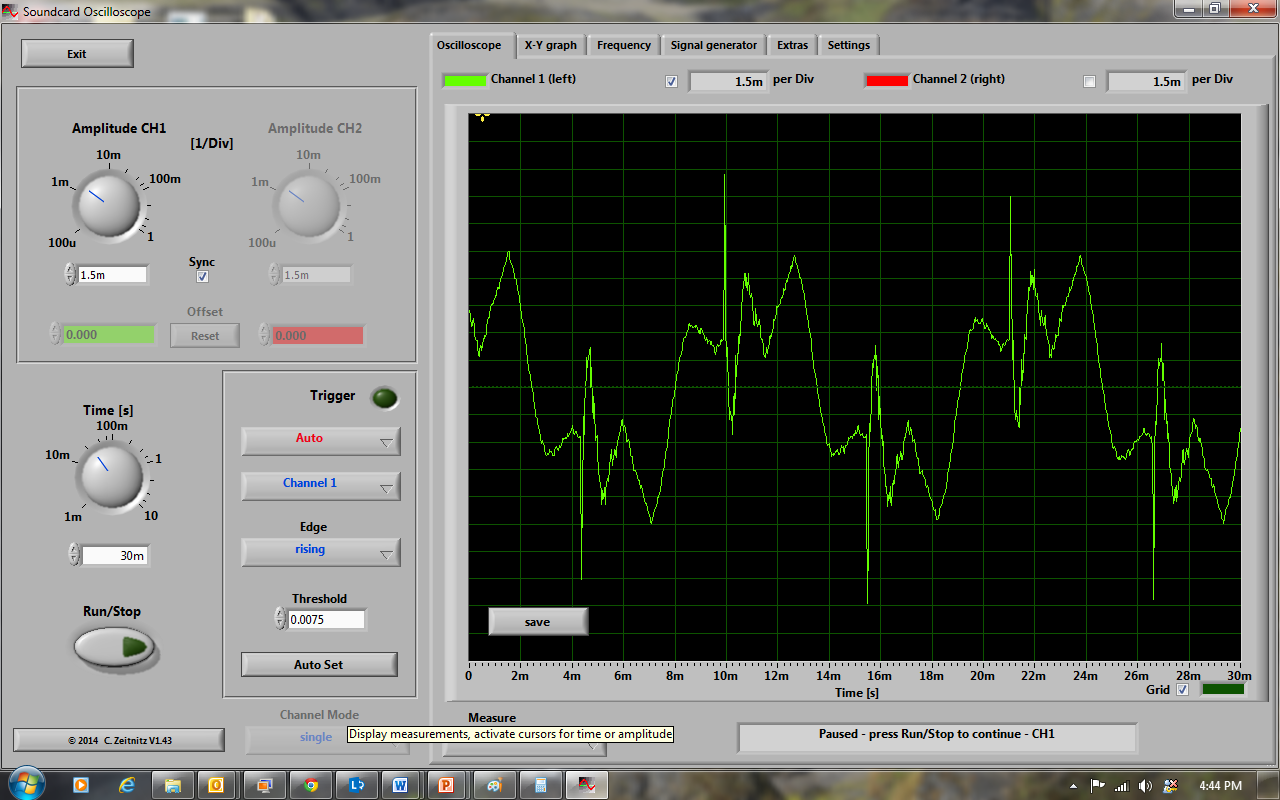
156 Hz
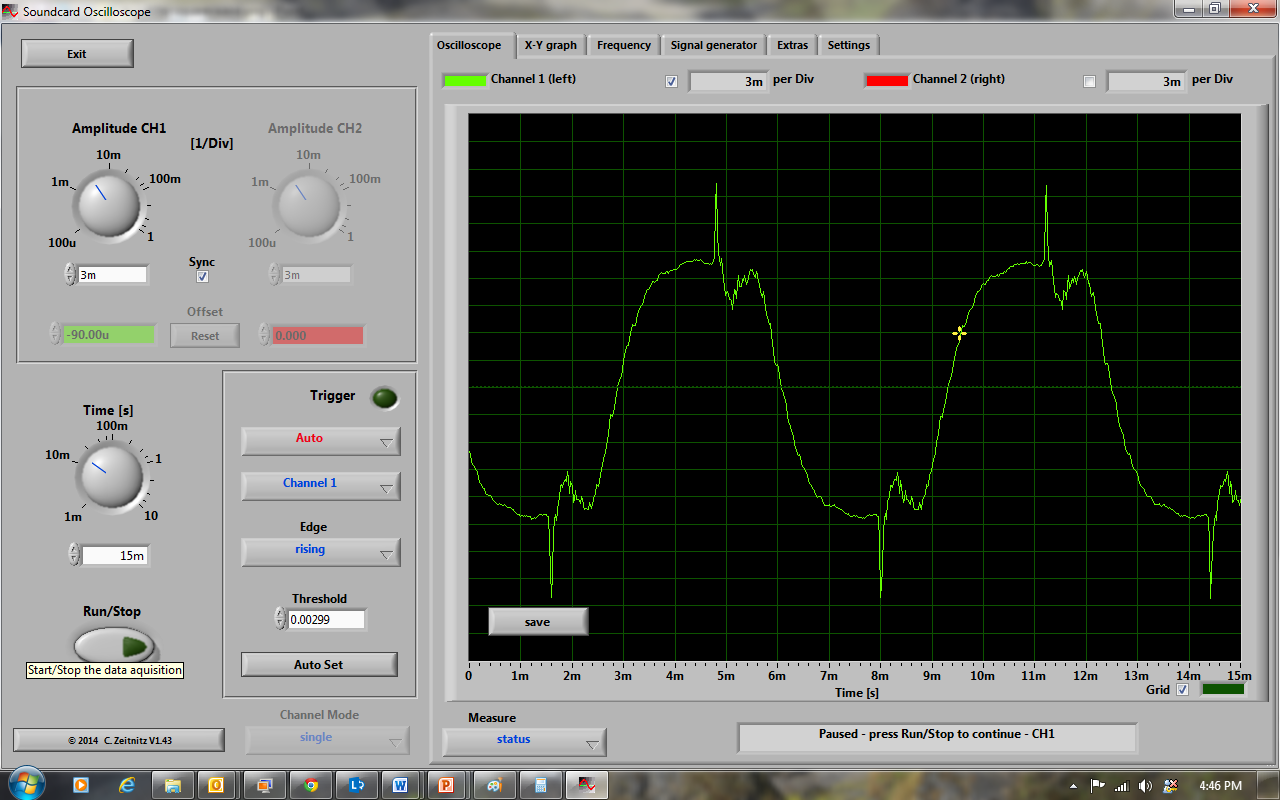
250 Hz
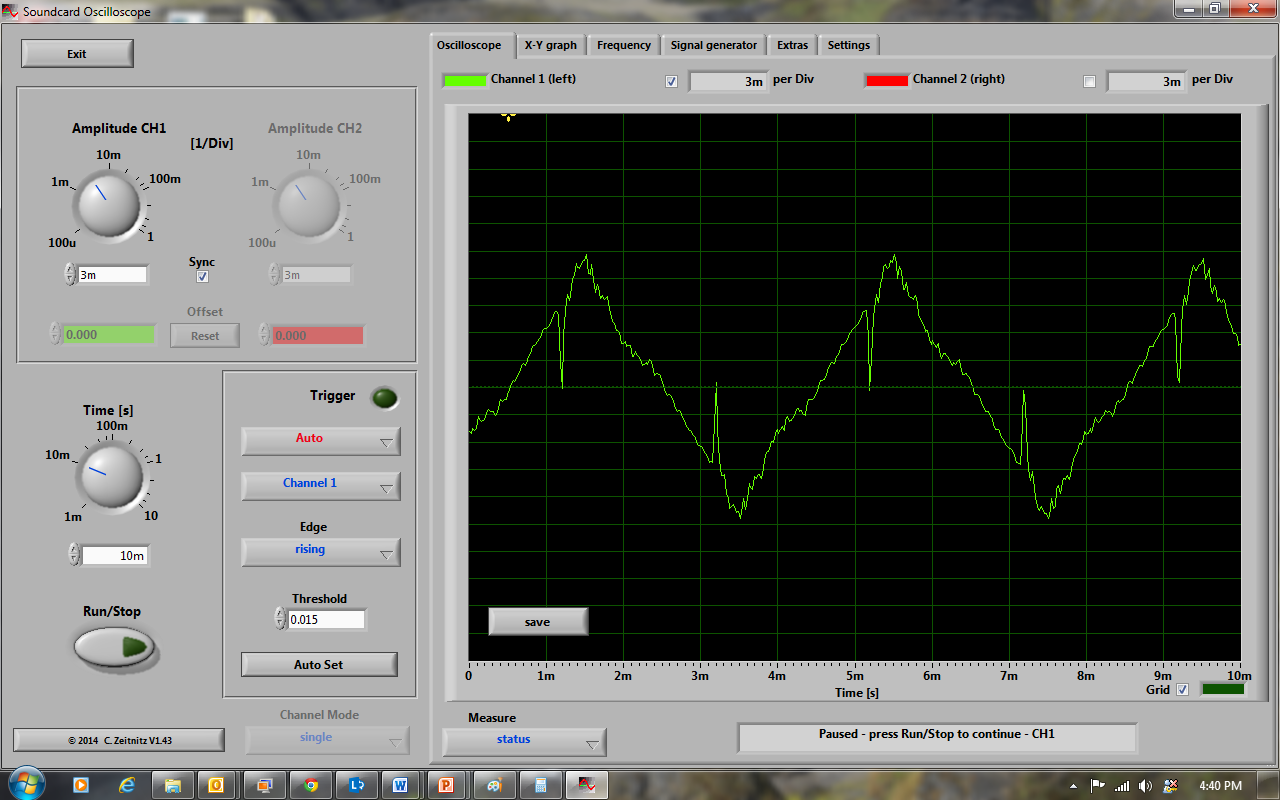
500 Hz
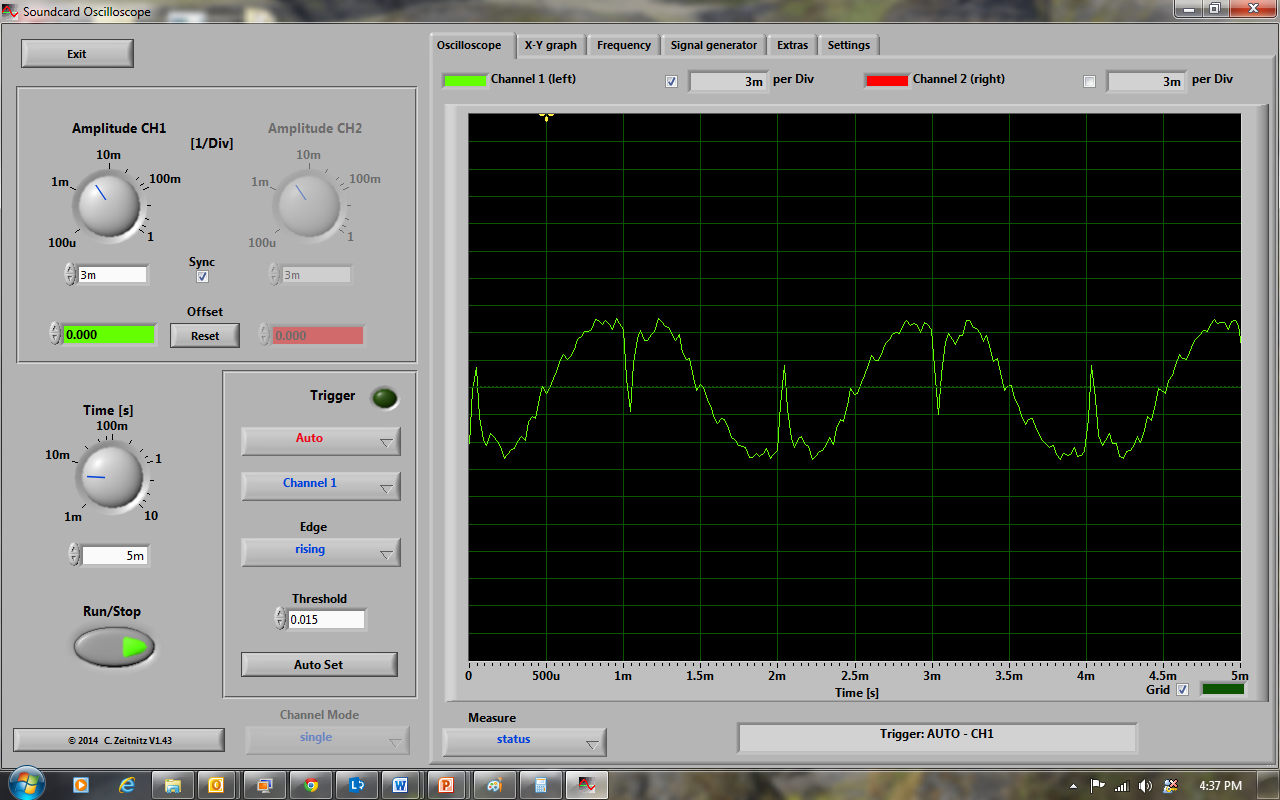
1kHz

1.5kHz
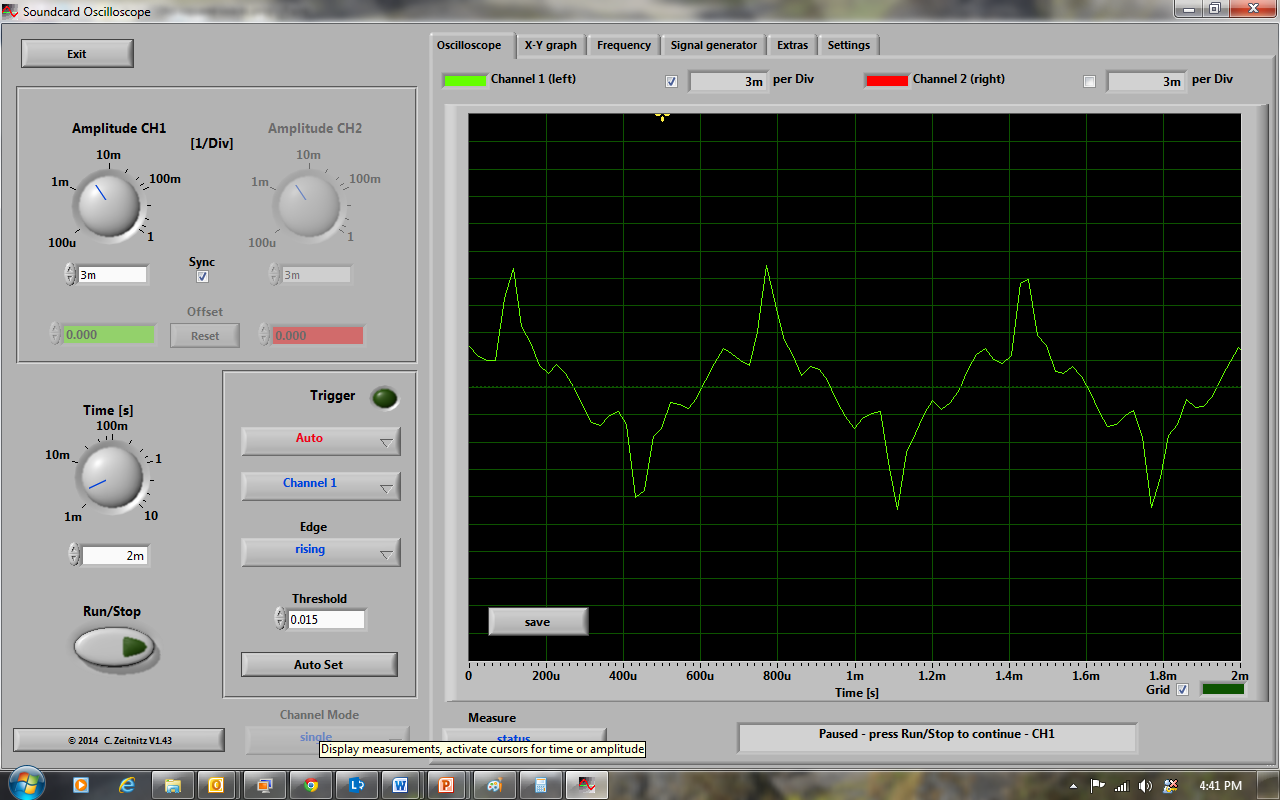
2kHz
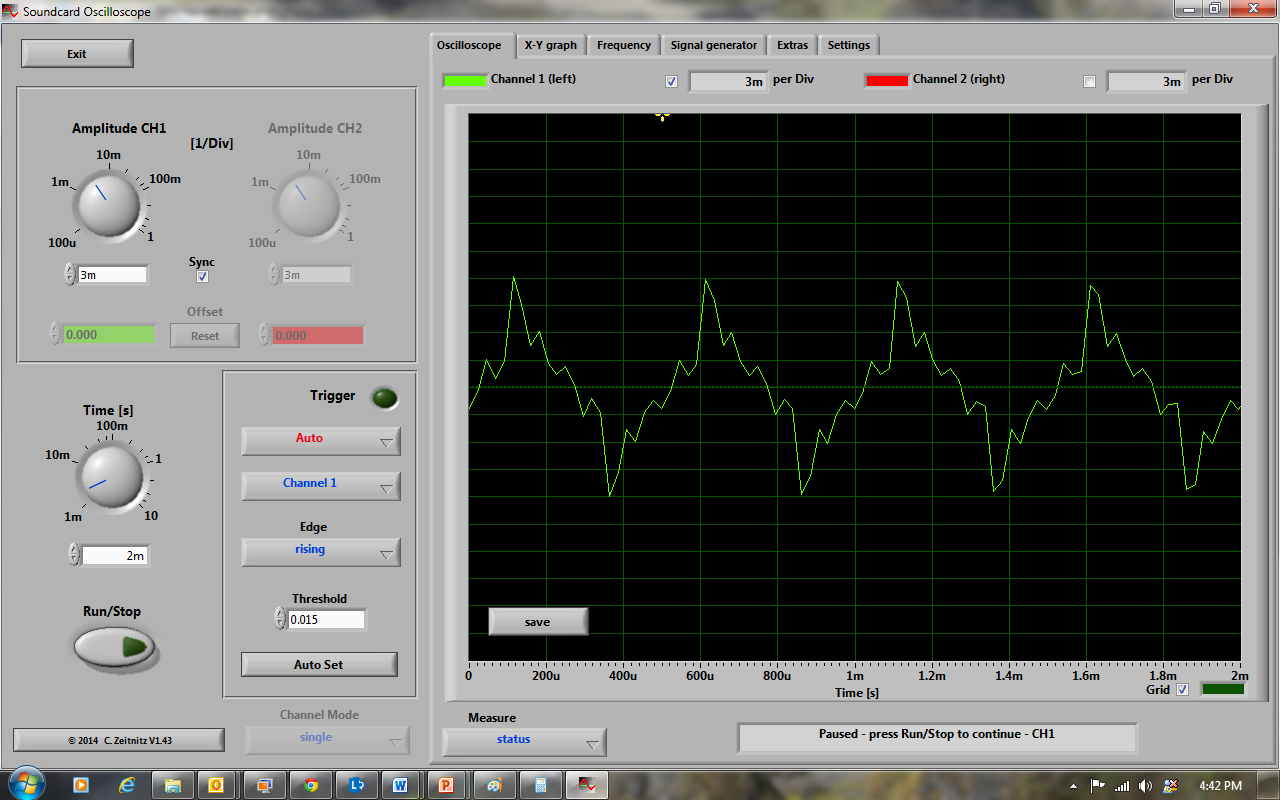
4kHz
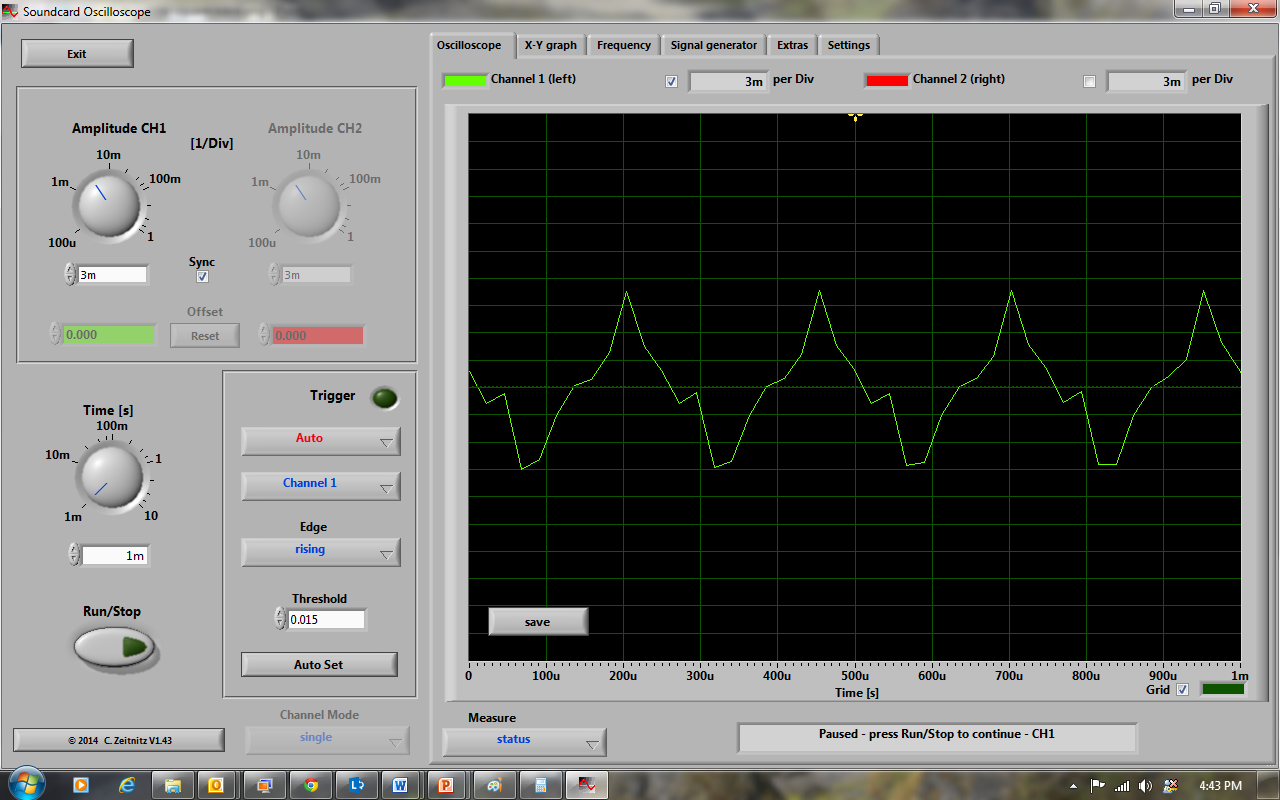
I do see the source of the sibillance though in the sharp spike that occurs - perhaps a remnant of class-D amplification?
Don't know...
I used the O-scope program that Legis suggested and the built in sound generator in REW to make the square waves. (I compared them against square waves in Audacity and got the same result).
I did it at several frequencies and found some that made more "square" than others and in general they look more like spikey triangle waves. The square wave test is indeed difficult for a speaker to replicate. I am not sure how much of this is the amp or the speaker. Maybe a good test would be a bare driver in an OB at low amplitude to see if it can make a square wave to start with.
90 Hz

156 Hz

250 Hz

500 Hz

1kHz

1.5kHz

2kHz

4kHz

I do see the source of the sibillance though in the sharp spike that occurs - perhaps a remnant of class-D amplification?
Don't know...
Attachments
-
 90hz-square-wave.png245 KB · Views: 748
90hz-square-wave.png245 KB · Views: 748 -
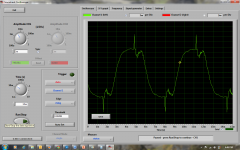 156hz-square-wave.png229 KB · Views: 764
156hz-square-wave.png229 KB · Views: 764 -
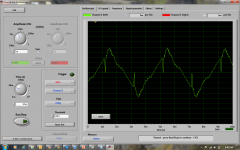 250hz-square-wave.png239.3 KB · Views: 745
250hz-square-wave.png239.3 KB · Views: 745 -
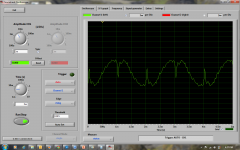 500hz-square-wave.png235.3 KB · Views: 756
500hz-square-wave.png235.3 KB · Views: 756 -
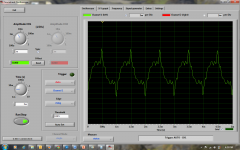 1khz-square-wave.png235.9 KB · Views: 744
1khz-square-wave.png235.9 KB · Views: 744 -
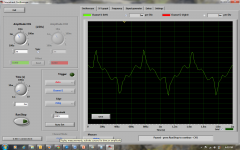 1.5khz-square-wave.png226.9 KB · Views: 735
1.5khz-square-wave.png226.9 KB · Views: 735 -
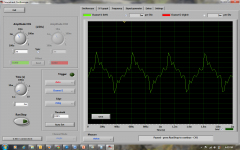 2khz-square-wave.png227 KB · Views: 733
2khz-square-wave.png227 KB · Views: 733 -
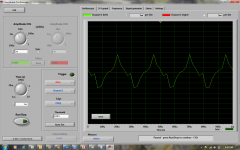 4khz-square-wave.png225.6 KB · Views: 719
4khz-square-wave.png225.6 KB · Views: 719
Last edited:
X, if the xo point was around 300Hz (?), then those higher freq squares should be more square-like if only one driver is producing them and it operates in "minimum phase". That requires that the cone moves in straight causation related to the current in the voice coil, ie. in pistonic manner. The first cone break-up mode is a definite sign that the the pistonic motion/minimum phase radiation has been at least somewhat lost beyond that frequency. This is how I understand it.
You could try the driver in closed box and see what it's like then. Also maybe OB would do with completely absorbed rear wave. Perhaps horn loading can make the cone bend more since it has to drive the air inside the horn. Tractrix flare does not load the cone uniformly/frequency independently, maybe it can also make some difference to cone-bending behaviour compared to horn flare that loads uniformly/frequency independently.
You could also try removing the equalization from the driver and test if it does make any difference. I think eq'ing a "minimum phase region" can have a different effect on phase response/group delay than eq'ing a "non-minimum phase region" of the response.
You could try the driver in closed box and see what it's like then. Also maybe OB would do with completely absorbed rear wave. Perhaps horn loading can make the cone bend more since it has to drive the air inside the horn. Tractrix flare does not load the cone uniformly/frequency independently, maybe it can also make some difference to cone-bending behaviour compared to horn flare that loads uniformly/frequency independently.
You could also try removing the equalization from the driver and test if it does make any difference. I think eq'ing a "minimum phase region" can have a different effect on phase response/group delay than eq'ing a "non-minimum phase region" of the response.
Last edited:
It would take a pretty screwed up amplifier to screw up a square wave as much as a speaker!
Remember that to reproduce a recognizable square wave, the frequency response has to:
1) Have a reasonably flat dB response (maybe within 3dB or so) from the fundamental frequency to about the 5th harmonic (extra points for 7th and 9th harmonics).
2) Have a phase response that can be made flat horizontal (within maybe 20 degrees or better) over that frequency range by only adding or subtracting a constant delay. You might do that with OmniMic or XSim.
3) That flat phase has to be either zero degrees or 180 degrees. In other words, between about -20degrees to +20degrees or between 160 degrees and -160 degrees. Flat phase at other angles (such as 45 or 90 degrees) won't be waveform accurate.
All that can be pretty hard to do. And not particularly worth it, as far as I've been able to tell.
BTW, square wave sweeps of my most recent are here:
square wave sweep 100Hz to 4kHz - YouTube
Not ideal, but pretty good all considered.
Unsmoothed, unwindowed frequency response of that one:

Remember that to reproduce a recognizable square wave, the frequency response has to:
1) Have a reasonably flat dB response (maybe within 3dB or so) from the fundamental frequency to about the 5th harmonic (extra points for 7th and 9th harmonics).
2) Have a phase response that can be made flat horizontal (within maybe 20 degrees or better) over that frequency range by only adding or subtracting a constant delay. You might do that with OmniMic or XSim.
3) That flat phase has to be either zero degrees or 180 degrees. In other words, between about -20degrees to +20degrees or between 160 degrees and -160 degrees. Flat phase at other angles (such as 45 or 90 degrees) won't be waveform accurate.
All that can be pretty hard to do. And not particularly worth it, as far as I've been able to tell.
BTW, square wave sweeps of my most recent are here:
square wave sweep 100Hz to 4kHz - YouTube
Not ideal, but pretty good all considered.
Unsmoothed, unwindowed frequency response of that one:

Bwaslo,
I don't yet have flat phase. It doesn't wrap from 500Hz to 10kHz. The Freq response is fairly flat though. Let me try testing on the Nautaloss first to make sure I know my driver and amp are natively capable of a square wave with a plain amp and no miniDSP. Your Synergy's response and phase are pretty amazing. To do that passively is quite a marvel. My hats off to you as a XO designer.
I don't yet have flat phase. It doesn't wrap from 500Hz to 10kHz. The Freq response is fairly flat though. Let me try testing on the Nautaloss first to make sure I know my driver and amp are natively capable of a square wave with a plain amp and no miniDSP. Your Synergy's response and phase are pretty amazing. To do that passively is quite a marvel. My hats off to you as a XO designer.
Last edited:
Great thanks, personal very interested this square wave info.
Regarding PC scope can i suggest program TrueRTA in level 1 (freeware) because it takes correction files verse Soundcard Oscilloscope, and it takes correction files for several devices in measurement chain as seen in picture-1 below marked with red squares. The programs license levels just affect the resolution in RTA function, not the signal generator and scope functions, just checked it myself running the freeware version on another PC.
A quick test here seems at a EQ'ed fullranger sealed running the correction file for UMM-6 verse not running correctionfile gives different relative square wave hit counts, when playing bwaslo file "squarewave sweep" or Legis files "A - 50-750 squarewave sweep mono 70sec / B - 750-4khz squarewave sweep mono 70sec".
Attached picture-2 visual RTA plot my personal UMM-6 correction file.
Link to freeware TrueRTA: True Audio: Audio Spectrum Analyzer and Loudspeaker Design Software
Regarding PC scope can i suggest program TrueRTA in level 1 (freeware) because it takes correction files verse Soundcard Oscilloscope, and it takes correction files for several devices in measurement chain as seen in picture-1 below marked with red squares. The programs license levels just affect the resolution in RTA function, not the signal generator and scope functions, just checked it myself running the freeware version on another PC.
A quick test here seems at a EQ'ed fullranger sealed running the correction file for UMM-6 verse not running correctionfile gives different relative square wave hit counts, when playing bwaslo file "squarewave sweep" or Legis files "A - 50-750 squarewave sweep mono 70sec / B - 750-4khz squarewave sweep mono 70sec".
Attached picture-2 visual RTA plot my personal UMM-6 correction file.
Link to freeware TrueRTA: True Audio: Audio Spectrum Analyzer and Loudspeaker Design Software
Attachments
xrk971, bwaslo suggestion post 189 regarding XSim, couldn't it spare you some time by loading into XSim the measurements you already have.
Never used the program before, did install and 10 minutes after produced plots as in pictures.
Picture-1 the example file i opened.
Picture-2 frequency/phase that system.
Picture-3/4 did a sweep and from ~650-2000Hz capable those waves.
Never used the program before, did install and 10 minutes after produced plots as in pictures.
Picture-1 the example file i opened.
Picture-2 frequency/phase that system.
Picture-3/4 did a sweep and from ~650-2000Hz capable those waves.
Attachments
Did you look at the step response of your newest setup?
Here is the step response of the setup that I just used to record the 'square' waves. (none of which were really that square)
Here is the frequency response of the 3FE22 and four woofers:

Here is the step response at the 1 ms timescale (also shown is the impulse response):
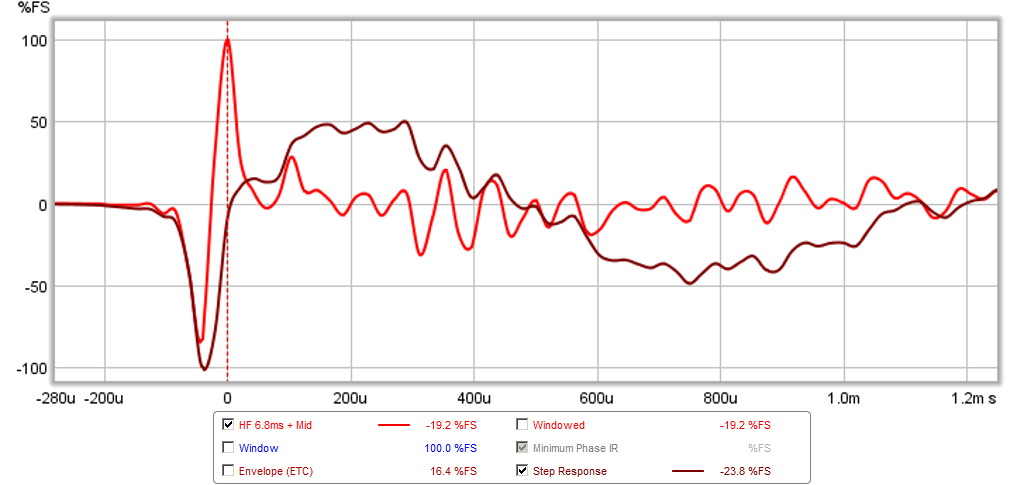
Here is the same step response over a longer 3 ms timescale:
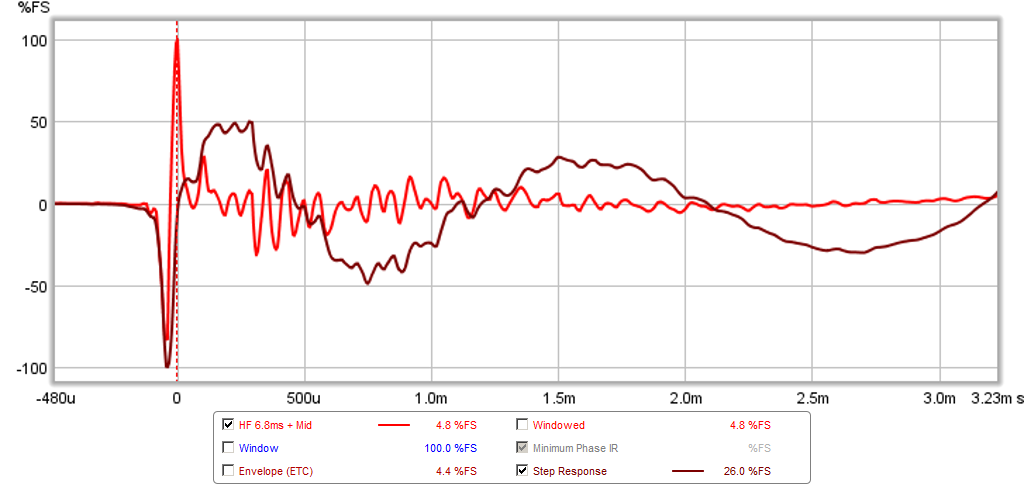
Attachments
- Home
- Loudspeakers
- Multi-Way
- Presenting the Trynergy - a full range tractrix synergy.
